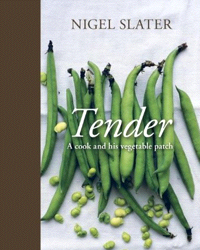Is there any doubt that this is the year of the vegetable cookbook?
Nigel Slater‘s Tender: A Cook and His Vegetable Patch (Ten Speed 2011) is one of the most lovely and inviting. He is one of the UK best cookery writers – search out his other books especially The Kitchen Diaries: A Year in the Kitchen with Nigel Slater. He writes narrative food books for all those who like to curl up in bed with a good read – a foodie read – and continue into the kitchen the next day. If you have the good fortune to have enough room for a vegetable garden – tear up that front lawn! – this book is your perfect companion.
The setting for Nigel’s story is a newly purchased “…house on a scruffy London terrace…” with a 40 foot long rectangular garden, that is luckily west facing. There are four pretty pictures of the garden in the four seasons (pp. 10-13) that show the six small vegetable beds, “…similar to those in early monastic gardens” (p. 009) Why take the time to grow your own? Nigel answers eloquently:
Watching someone you love eat a tomato you have grown yourself makes it more than just a tomato. It becomes a source of glorious, yet strangely humbling, pleasure… I am a gentle cook, and one who believes that there is delight in food far beyond what is on the plate. Choosing a seed from a catalogue (who could resist a squash named Amish Pie or an apple called Cornish Gillyflower?), planting it, nurturing it to harvest, then picking it and taking it into the kitchen adds more to the satisfaction of a supper than any amount of flashy presentation. (p. 023)
 There are 29 vegetables in the book, arranged alphabetically from asparagus to zucchini. Each has a section that discusses growing and then cooking with the ingredient. As an example, in the middle of the book is a vibrantly green picture with a fava bean flower in the center by Jonathan Lovekin.
There are 29 vegetables in the book, arranged alphabetically from asparagus to zucchini. Each has a section that discusses growing and then cooking with the ingredient. As an example, in the middle of the book is a vibrantly green picture with a fava bean flower in the center by Jonathan Lovekin.
I only truly appreciated fava beans once I had seen them growing. The flowers, pure white, black and white, or the deep crimson-pink of an archbishop’s robe, have a scent that wafts lightly on the air. The smell takes you by surprise on a cold spring day, like a sudden blast of winter jasmine, hitting you when you least expect it. (p. 231)
There are sections on gardening and using fava beans in the kitchen. The recipes range from A Risotto of Young Beans and Blue Cheese (p. 237) to Fava Beans, Herbs, Bacon, and Its Fat (p 244) with dill, mint, and vinegar, and a lovely Fava Bean Frittata (p. 248).
This is not in the least a vegetarian book, rather a book about how to grow, cook, and appreciate the marvels of vegetables. It is wonderfully thick – with enough recipes and good writing to get you through the hottest summer.

2 comments on “Nigel Slater: Tender”